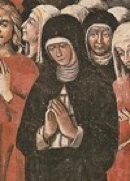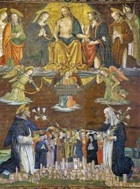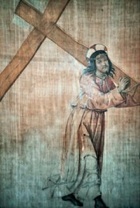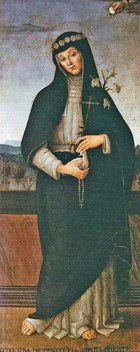


Blessed Colomba
Detail of gonfalon (1494) illustrated below
An entry in the Martyrology of the Sacred Order of Friars Preachers under 20th May records: “At Perugia, Blessed Colomba of Rieti virgin, of the Order of our Father St Dominic. She was renowned for her purity, patience, and abstinence.”
The Blessed Colomba (Angelella Guadagnoli, 1467-1501), who attended the Dominican church in her native Rieti from an early age, was particularly influenced by the life of St Catherine of Siena. She joined the Dominican third order in 1486 and performed her first miracle (an exorcism) during a pilgrimage in 1487 to the sanctuary of Santa Maria della Quercia, outside Viterbo. When she returned to Rieti, she had a vision in which she was inspired to set out on foot for a destination that would be revealed to her. When she reached Foligno, she sought hospitality at the nunnery of Santa Maria del Popolo. She aroused suspicion and was briefly arrested, but was then allowed to continue to Santa Maria degli Angeli, outside Assisi. It was here that it was revealed to her that she should go to Perugia. At that time (1488) Rodolfo and Guido Baglioni had just driven the Oddi faction from the city.
The Dominicans of Perugia were initially reluctant to accept her. However, she received a boisterous welcome from the people and was conducted to the house of two Dominican tertiaries near San Domenico. She soon established a reputation for holiness, prophecy and the performance of miracles, and her stern warnings to powerful men like Rodolfo and Guido Baglioni was particularly appreciated.
The Blessed Colomba took vows at San Domenico before its Prior, Stefano da Gaeta, on 1st January 1490. The small community of nuns began to attract noble women, and she decided to establish a nunnery near San Domenico in what is now Corso Cavour dedicated to St Catherine of Siena (later the Monastero della Beata Colomba). The new nunnery received substantial subsidies from the Dieci dell' Arbitri in the period 1492-4. The Blessed Colomba laid the foundation stone of a new dormitory and refectory for the growing community in 1493. By that time, the construction of an oratory for the nuns was already underway. Funds were probably also raised when the intercession of the Blessed Colomba was thought to have mitigated the effects of plague in the city in 1494. Later in 1494, the Dominicans appointed Fra Sebastiano Bontempi as her confessor. (He wrote the fundamental source for her life in 1501-6).
When Pope Alexander VI and his son Cesare Borgia visited Perugia in June 1495 (as he took refuge in Perugia as King Charles VIII marched across Italy), they stayed near San Domenico [in the house of Alberto Baglioni?], and Fra Sebastiano introduced him to the Blessed Colomba. Fra Sebastiano reminded Cesare Borgia of one of her miracles that they had both witnessed when Cesare had been a student at Perugia (in 1489-91): the Blessed Colomba had revived a dead child in San Domenico and Cesare and Grifonetto Baglioni had wanted the bells rung, but Fra. Sebastiano (then sceptical about her authenticity) had refused.
Alexander VI granted indulgences for those praying in the Cappella di Santa Caterina in San Domenico in order to finance further work on the new nunnery. When the nominal prioress of the community died in 1497, the Blessed Colomba formally succeeded her. Sebastiano Bontempi came under suspicion as a follower of Savonarola, and a friar called Andrea da Perugia replaced him as confessor to the Blessed Colomba.
The Blessed Colomba was herself not above suspicion, and she was increasingly restricted in her public activities. She nevertheless received the support of successive papal legates who solicited papal indulgences for her: first Cardinal Juan Borgia the Younger (papal governor in 1495; legate ot Perugia and Umbria in 1497; died 1500); and then Cardinal Raimondo Perauld (Raymund Pérault, legate to Perugia and Todi in 1499).
In 1499, Pope Alexander VI took advice from the Blessed Colomba on the authenticity of the stigmatisation of the Blessed Lucy of Narni.
The community of the Blessed Colomba was a beneficiary of funds raised in the Jubilee of 1500. The legates also arranged that she should be given a new spiritual advisor, Fra Michele da Genova. He remained in this position until her death in the following year. She was buried in the Cappella di Santa Caterina, San Domenico.
In 1566, Pope Pius V conceded that the nuns of what was then known as the Monastero delle Colombe could celebrate her memory on the anniversary of her death. A formal process for her canonisation in 1629-30 failed. Pope Benedict XIII recognised the celebration of the feast within the Dominican Order and at Perugia and Rieti in 1725.
Relics of the Blessed Colomba
The Blessed Colomba was buried under the Altare di Santa Caterina in San Domenico. [Are her relics still there ??]
The the Cappella di Beata Colomba in the Monastero della Beata Colomba in Corso Garibaldi is a replica of Beata Colomba’s original cell in Corso Cavour. It houses her bed and some of her other personal possessions. A relic of her cranium is preserved under the chapel’s altar.
Art and the Blessed Colomba
Gonfalon (1494)

The altarpiece depicts SS Dominic and Catherine of Siena protecting Perugia from the arrows of angels. Above, Christ sits in judgement, flanked by the Virgin and SS John the Baptist, Sebastian, Andrew, Laurence and (probably) Herculanus. Perugia is represented by a group of citizens and a fine cityscape, The female Dominican in prayer, to the left of St Catherine of Siena (i.e. on the saint’s right), probably represents the Blessed Colomba da Rieti.
This banner has traditionally been attributed to Giannicola di Paolo, but it has been more recently attributed to Fiorenzo di Lorenzo or perhaps to someone in his circle.
By 1630, the banner was in the Cappella del Rosario of San Domenico Vecchio. It is now used as the altarpiece of is the Cappella del Gonfalone, San Domenico. The original wooden frame in which it was carried in processions is on the left wall of the Cappella di San Vincenzo Ferreri there.
Christ Carrying the Cross (ca. 1497)

This panel is apparently documented as in existence in September 1497. It is usually attributed to the young Giovanni di Pietro, lo Spagna, but its poor state of conservation make this uncertain. If he did indeed paint it before the documented date, it is his earliest known work.
Blessed Colomba da Rieti (ca. 1505)

The panel depicts the Blessed Colomba standing on a terrace set in a landscape. She holds a dove, a rosary, a small wooden cross and a lily. The hand of Jesus appears in the top right hand corner, offering her the Host. The inscription along the bottom that identifies her seems to be a later addition.
Read more:
G. Casgrande and E Menesto (Eds), “Una Santa, una Città: Atti del Convegno Storico nel V Centenario della Venuta a Perugia di Colomba da Rieti, Perugia 10-12 Novembre 1989”, Spoleto (1991)
Return to Saints of Perugia.

